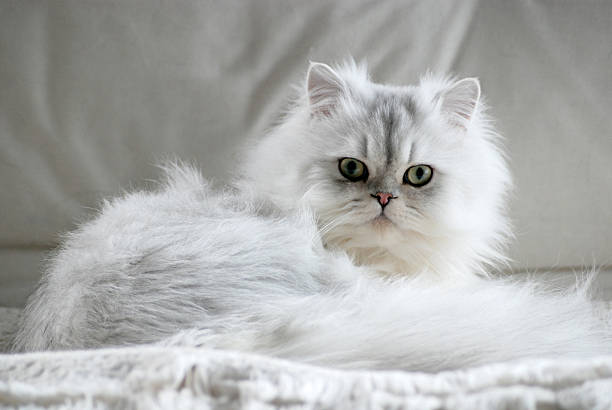Persian Cat

History:
The Persian Cat is one of the oldest and most recognisable cat breeds, with origins tracing back to ancient Persia (modern-day Iran). They were first introduced to Europe in the 1600s and gained popularity for their luxurious coats and dignified demeanour. The modern Persian, especially as seen in the West, was selectively bred in the 19th and 20th centuries in Britain and the United States to enhance its signature flat face and plush coat. Revered for their calm, gentle personalities and regal appearance, Persian Cats have long been a favourite in cat shows and among royalty and celebrities. Their laid-back nature and quiet presence make them ideal indoor companions.
Size: Medium to large-sized cat
Height: 25–38 cm
Weight: 3–6 kg
Life Expectancy: 12 to 17 years

Breed Appearance:
The Persian Cat is a medium to large-sized breed with a stocky, cobby build, short legs, and a broad chest. Its most defining feature is its round, flat face with a snub nose, full cheeks, and large, expressive round eyes that can come in various colours, depending on the coat. The ears are small, rounded, and set wide apart, complementing its rounded head. The breed's thick, long double coat is incredibly soft and comes in a vast array of colours and patterns, including solid, tabby, bi-colour, and more.
Persians move with a slow, deliberate grace and have short, thick tails carried low. Their coat requires regular grooming, but it contributes greatly to their striking appearance. The overall look is one of luxury, softness, and elegance—traits that have made the Persian an enduring symbol of feline beauty.
Health & Care:
Persian Cats are prone to several breed-specific health issues, particularly due to their brachycephalic (flat-faced) structure. Common concerns include breathing difficulties, dental malocclusions, eye conditions like tear staining, and polycystic kidney disease (PKD). Responsible breeding and regular veterinary checkups are essential for maintaining their health. Their long, dense coat requires daily grooming to prevent mats and tangles. Eye cleaning and dental hygiene should be part of a consistent care routine. Persians do best on a high-quality diet and benefit from indoor living to protect their coat and reduce exposure to allergens or pollutants.

Living Conditions:
Persians thrive in calm, stable home environments where they can feel secure and pampered. They are indoor cats by nature and should be kept inside due to their delicate grooming needs and sensitivity to extreme temperatures. Persians enjoy cozy spots, soft bedding, and peaceful surroundings. They are ideal for apartment living or homes without too much noise or chaos. These cats are affectionate without being clingy and prefer predictable routines. While they get along with gentle children and other laid-back pets, they may be overwhelmed by active dogs or rambunctious play. A quiet, nurturing setting helps them flourish.
Grooming:
Grooming is a critical part of caring for a Persian Cat. Their long, thick, and silky coat needs daily brushing to prevent matting and hairballs. A metal comb and slicker brush are often recommended. Regular bathing—every few weeks—may be necessary to keep the coat clean and reduce oil buildup, especially for show Persians. Eye discharge should be cleaned daily, particularly in flat-faced individuals, and ears and nails require routine attention. Dental care is also important due to jaw structure. Though grooming can be time-consuming, it provides an opportunity for bonding and ensures their luxurious appearance is well-maintained.

Advantages:
-
Persian Cats are exceptionally calm, affectionate, and gentle, making them ideal companions for quiet households or individuals seeking a relaxed, low-key pet.
-
Their serene nature and low activity levels make them well-suited for indoor living, apartments, and owners who prefer less rambunctious behaviour.
-
Persians form strong bonds with their people and offer loyal companionship, often following their owners from room to room without being intrusive.
-
Their iconic, luxurious appearance and sweet expression have enduring appeal and make them favourites among cat lovers and show enthusiasts alike.
-
They are generally undemanding and content with a stable routine, cosy spaces, and gentle attention, making them easy to live with for many households.
Disadvantages:
-
Their long, dense coat requires daily grooming and frequent maintenance to prevent mats, tangles, and hygiene issues, which may be too time-consuming for some owners.
-
Persians can be prone to several health problems, including respiratory issues, kidney disease, and eye infections, necessitating regular veterinary care and careful monitoring.
-
Their flat-faced structure can cause discomfort or breathing difficulties, especially in hot or humid conditions, and may limit their ability to exercise vigorously.
-
They are less interactive and playful than more active breeds, which may not appeal to families looking for a highly energetic or entertaining cat.
-
Due to their quiet, sensitive temperament, Persians may be stressed by loud environments, active children, or frequent changes in routine, requiring a peaceful, predictable home.

